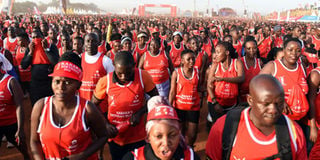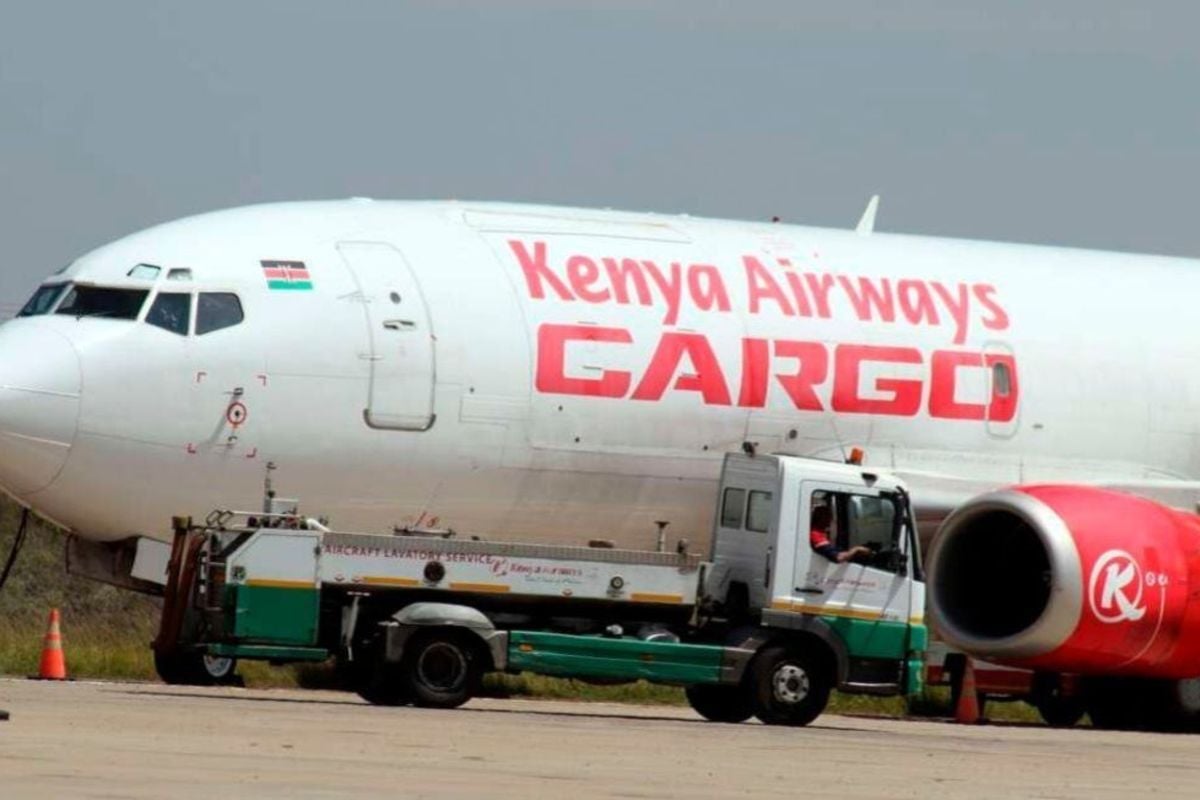Where does money from charity runs go?

Running for a cause. People take part in the Kabaka’s birthday run last month. The run happens the weekend before the king’s birthday. PHOTOS BY ISMAEL KEZAALA
What you need to know:
Purpose: Saturday Monitor’s Joan Salmon takes you on a journey to find out if the pledges by these runs or the slogans by which they are advertised have been fulfilled.
For years, several marathons have gone on in the country with pledges to better the lives of people in one way or another. Call it giving back to the community. Nonetheless, many people, corporates and individuals alike, have contributed in form of donations or buying kits.
For the just concluded Kabaka Birthday Run, the Kabaka (King) of Buganda, Ronald Muwenda Mutebi II, through the second deputy prime minister (Katikkiro) Robert Waggwa Nsibirwa, announced that the Shs494m collected would be injected in sickle cell prevention and treatment campaign.
“The Kabaka has earmarked Shs200m to be given to central laboratories to buy testing kits so people are tested free of charge. He has also allocated Shs294m to support awareness campaigns and public health initiatives because we all know that sometimes our people land into problems for lack of information about sickle cells and that is why he has given the bigger budget to go for awareness so that people know where to go for free services and treatment given by the Buganda Kingdom,” Mr Nsibirwa said.
Could this be the trend that other runs have taken?

For a cause. Some of the participants in one of the Rotary runs in Kampala.
Rotary runs
In 2011, Rotarian Stephen Mwanje came up with an idea to set up a specialist cancer ward. “He started sharing his idea with some of his corporate friends and before we knew it, Nsambya Hospital had given us land, while Centenary Bank gave us seed money. Many other corporate organisations stepped up to support the initiative, including Crown Beverages and Bank of Uganda. With the plan off the ground, we began thinking about how to sustain the cause,” Rotarian Henry Rugamba shares.
The ‘how’ was discovered when Mwanje attended a Dar-es-Salaam rotary run famously known as the Dar Marathon and that marked the birth of rotary runs in Uganda.
“The run has grown to attract more individual runners, more corporate organisations…we have developed great branding for the run and we have noticed and increased appetite to participate and get involved, thus increasing the revenue raised,” Rugamba says.
The run started in 2012, and has been held every last Sunday of August since then. “In the start, we thought we would need at least five years to raise the money for the ward but owing to the overwhelming support of the people, construction was completed in three years and the ward handed over to Nsambya Hospital in 2015,” Mwanje says. He adds that money raised from the 2015 run was thus given to Mengo Hospital blood bank.
“That year, we ran for blood,” he shares.
“Besides the ward, through rotary friends – and international partners, we were able to put up two global grants. Through these, we got some basic equipment that enabled the ward to be operational. We were also able to take some staff of Nsambya Hospital for training in the US,” Mwanje adds.
While they had originally planned that after 2015, they would go to other parts of the country improving the infrastructure of the various cancer wards; the collapse of the only radiotherapy machine in Uganda housed at Mulago National Referral Hospital forced the committee to revisit their strategy. The most urgent need then was getting equipment for radiotherapy at Nsambya Hospital.
“Seeing the dire need, we chose to take on an ambitious cause of buying two rather than one Linear Accelerator machines as earlier agreed. This also meant getting the money for building the bunkers, which house the machines. ” Mwanje says.
“So, from 2016, the Rotary runs have been focused on collecting money to build the bunkers, which cost about $2m (Shs7.4b)” Rugamba says.
“Through our networks and our Rotary Foundation, we hope to get the machine but not the bunkers as they do not fund building projects,” he adds.
At the moment, Mwanje says the technical team is working on designs and approvals.
“With Shs1.6b at hand, we are hoping that by June, we will be doing the ground breaking, as well as launching the 2019 run that will be held on August 25.”
Rugamba also points out that through these runs, awareness has been raised and among other things, led to the creation of the Uganda Rotary Cancer Awareness Programme that has pooled several professionals, who are rendering their services to the cause free of charge. “We are also exceptionally thankful to our parliamentarians who, since 2017, give us Shs1m each and Centenary Bank which has been our major funder from 2012,” Rugamba applauds.

Product. The cancer ward at Nsambya Hospital that was constructed with proceeds from marathons organised by the Rotarians in Kampala. FILE PHOTO.
Kabaka birthday runs
The run organised in commemoration of Kabala Ronald Muwenda Mutebi’s April 13 birthday started in 2013. The run happens the weekend before the king’s birthday and proceeds from the run are used for different social causes, with the first having been fistula.
“We do this with Buganda Kingdom,” Charity Rwabutomize Bukenya, the corporate social responsibility manager at Airtel Uganda, shares.
Bukenya applauds the run, saying: “For the case of fistula, many did not know about it and those with it did not know where to go for help. There was a lot of pain and discrimination that this run dealt with in one way or another. Awareness was created and unlike before, people are now aware that early pregnancies and a birth gone wrong are leading causes of fistula.”
Bukenya also points out that people now know that at Kitovu Hospital, patients can access treatment.
“Though some people knew, many did not and the number of people seeking treatment has grown,” Bukenya says.
The runs for that cause went on up to 2016 and in 2017, they moved on to sickle cell.
With awareness growing, so has the numbers of people coming for the runs, “From only 60,000 kits to more than 100,000, shows commendable growth and the fact that people are buying into what we believe in,” Bukenya says.
Before the sickle cell drive, Bukenya says people were only interested in the common tests such as HIV and Hepatitis B.
“Sickle cells was never talked about yet it is important, especially for unborn babies. But with this awareness, fathers won’t deny their children just because one of them has the disease. It will also reduce the disease burden as people will make an informed decision before committing to a partner,” Bukenya adds.
Airtel Uganda also partners with Uganda Health Laboratory Services, who say one in every seven children has sickle cells, while one in every four children in every district has the disease. “We are, however, thankful that through these runs, more people are testing and we discovered that more people tested positive to having sickle cell traits than HIV or other feared illnesses,” Bukenya reveals.

For water. Former MTN chief executive officer Mazen Mroue during the commissioning of one of several boreholes in Kryandongo Districts constructed from proceeds raised from the MTN marathons. MONITOR PHOTO
MTN Kampala Marathon
The marathon is an annual MTN Uganda initiative aimed at creating opportunity for all Ugandans and non-Ugandans to contribute towards the development of the country.
“Over the last 11 years, the marathon has grown to become a great sporting event in Uganda, with more people from all walks of life participating in the event to donate towards a noble and worthy cause,” Valery Okecho, the MTN Uganda spokesperson, says.
He adds that the number of individuals and corporate companies participating in the marathon has grown exponentially over the years from 1,500 runners in 2004 to a capped number of 25,000 to date.
Apart from the fun and athletics, Okecho says the marathon has always been run for a cause towards various underprivileged communities and individuals. The various initiatives the marathon has supported since its inception in 2004 include Uganda Red Cross Mama Bag appeal (2004 – 2006) and Uganda Red Cross Resettlement appeal (2007 – 2010), which were mainly focused on expectant women in the Internally displaced people camps during the two decade war Lord’s Resistance Army insurgency in northern Uganda.
Besides, there was the water and sanitation projects in Amuria (2011), Kiryandongo (2012), Nakapiripirit (2013) and Kotido (2014). These were followed by sanitation in schools around Kampala project in 2015 and 2016. From then, the marathons moved to the removal of asbestos roofings in KCCA Schools and improving maternal health in Komamboga and Kiswa Health Centres in 2017.
Last year, the marathon focused on improving maternal health in selected health centres in Kampala, Mbarara, Hoima, Gulu and Mbale districts.

Hands-on. NSSF managing director Richard Byarugaba participates in one of the NSSF 7 Hills marathons. FILE PHOTO
NSSF 7 hills marathon
This run is geared towards improving the status of schools in Kampala. Richard Byarugaba, the National Social Security Fund (NSSF) managing director, says: “NSSF is proud to help the less privileged in society and it is for this reason that the Fund wants to improve sanitation in KCCA schools.”
He says their motive is to reach out to the children who study in Kampala public schools by progressively raising funds to contribute to the improvement of the learning conditions and environment in which they study from.
“We were meant to collect Shs300m to the cause but this year, we expanded our reach to cater for schools out of Kampala,” Byarugaba says.
The run that was solely funded by the Fund for the first three years, has now opened up to the public.
“Originally, it was only open to corporates but we have also brought individuals on board. With that, we collected Shs530m, over and above our mark of Shs500m for the year,” Byaruhanga said.




